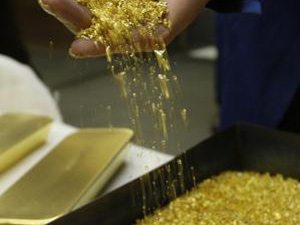
[miningmx.com] – SOUTH African gold shares have stormed back this year, a trend in keeping with international trading activity where analysts have forecast that gold equities would outperform the price of the metal.
Sibanye Gold, for instance, has doubled in value this year whilst AngloGold Ashanti was among the best performing stocks on Johannesburg’s Top 40 index. Gold Fields and Harmony Gold have also performed well, although not as impressively.
One of the reasons for the strong performance of gold shares this year was the most obvious: an increase in the gold price. The crisis in the Ukraine underpinned the safe-haven characteristics of gold which was partly demonstrated in renewed interest in exchange traded products (ETP).
During mid-March, holdings in ETPs registered their highest weekly increase since November 2012 with total holdings then up to 1,766 tonnes – the highest accumulation since December 27.
It’s also thought fund managers were underweight in gold stocks and subsequently rebalanced their exposure. The gold price improvement coupled with recognition that management had made serious in-roads into cost cutting – a fact assisted by the adoption of the All-In Sustaining Costs (AISC) reporting standard – also drove renewed interest in gold stocks.
Finally, from the perspective of South African gold shares, the deterioration of the rand against the dollar helped improve the revenues of gold producers: the rand gold price has been challenging historic highs.
More recently, however, the shares have fallen off. In the case of Sibanye Gold, the weakness is partly a natural correction, says Daniel Sacks, an analyst for Investec Asset Management.
But there is a question as to whether South African gold stocks have run their course this year. According to Macquarie Research, South African gold stocks have run beyond a reasonable level of value based on its expectation of a stronger rand and weaker gold price.
The gold price has weakened. Comments from the US Federal Reserve is that following the end of bond buying, undertaken by the Fed during the financial crisis to keep the market liquid, there may be an increase in interest rates. Higher interest rates dampen inflation against which the gold price is inversely correlated.
The rand, however, has remained relatively consistent at 10.86 to the dollar since the beginning of the month following its 18% deterioration in the last 12 months. And according to an article in Bloomberg News, which cited investment reports of UBS and Lombard Street Research, the rand is still about 10% too expensive.
“We will be wrong if the rand remains at these levels and the gold price remains strong,’ said Macquarie in its report, adding that the market was already pricing in these conditions.
“Enough uncertainty remains for gold to maintain a level of support above $1,325/oz,’ said Ole Hansen, an analyst for Saxo Capital Markets in an e-mailed report. “However, any heating up of the geopolitical situation could quickly stimulate demand for gold,’ he said.
As for the rand, the expectation is that it will remain under pressure as the country nears national elections, scheduled for May 7. The effect of the currency on gold shares is dramatic.
Says James Wellsted, head of corporate affairs for Sibanye Gold: “We produced R3.6bn in free cash flow last year at an average rand gold price of R435,000/kg. This year, the price is about R450,000/kg which is expected to generate upwards of R4bn in free cash flow’.
“For the first time in a long time, there’s real gearing in the earnings of gold producers with the gold price going up and costs actually coming down,’ he says.








